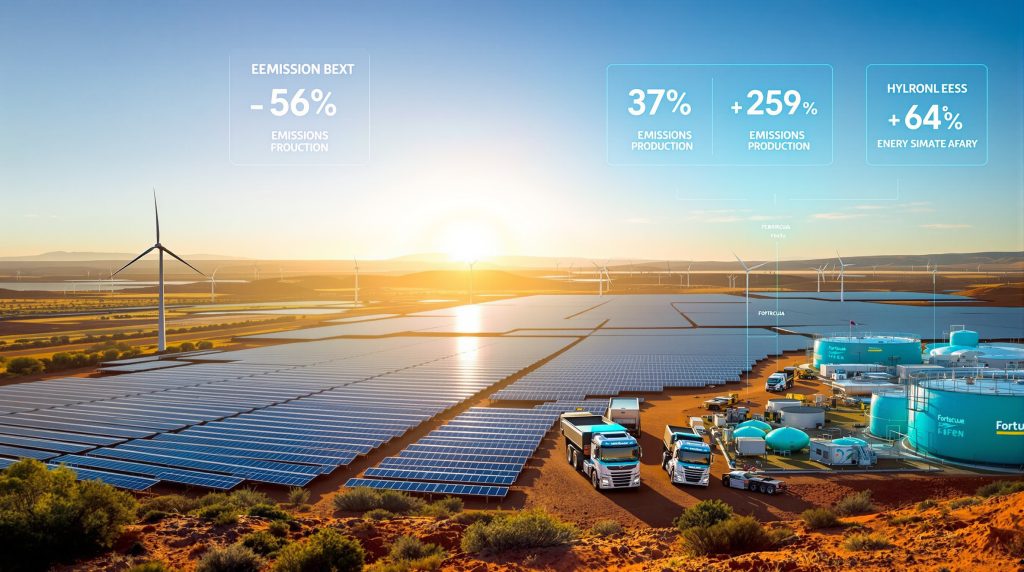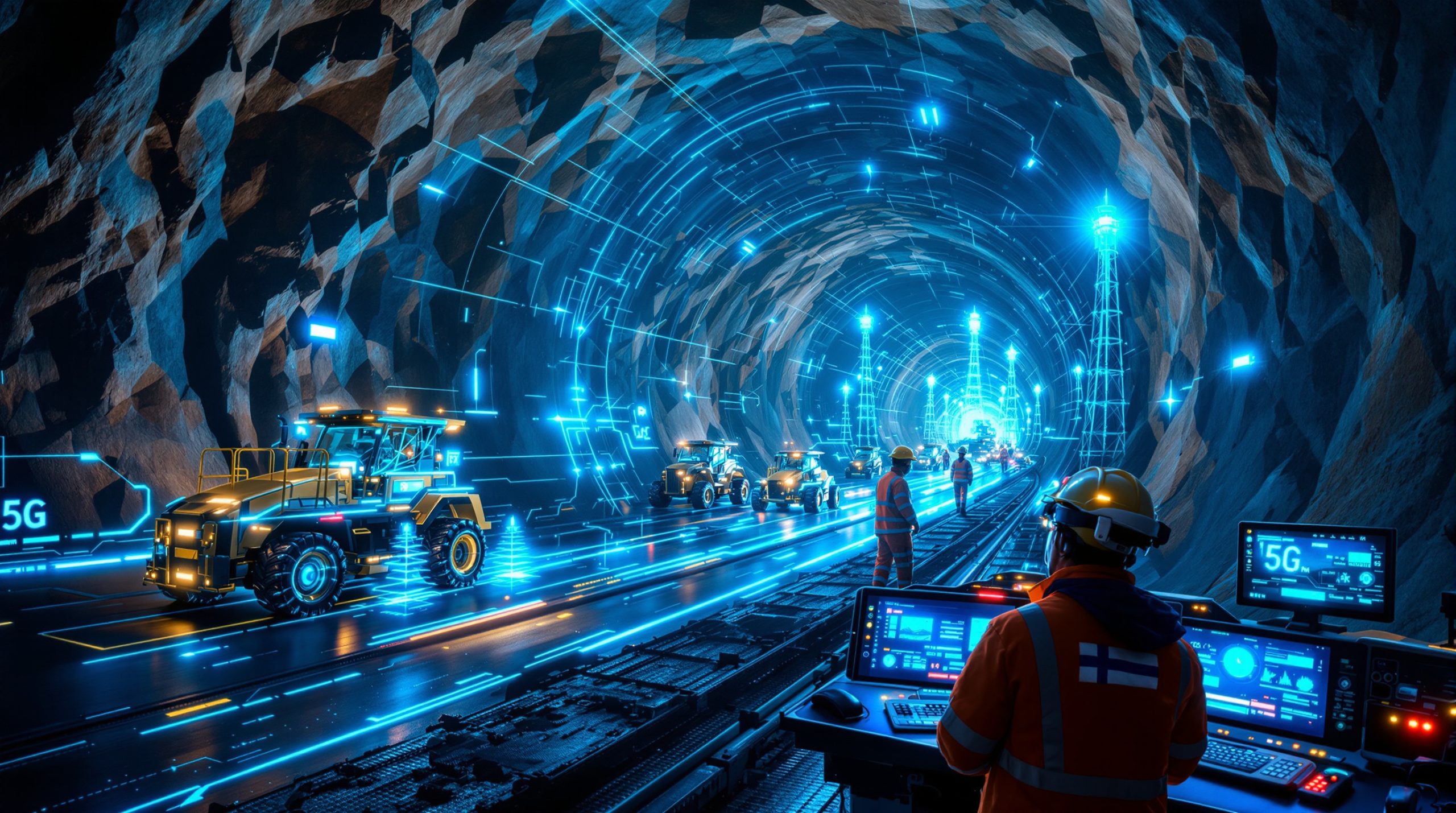How Is Fortescue Transforming Its Operations Through Renewable Energy?
Fortescue Metals Group stands at the forefront of mining industry transformation, implementing one of the sector's most ambitious renewable energy solutions. While competitors typically target net-zero emissions by 2050, Fortescue has committed to complete decarbonization by 2030—setting a timeline that positions the company as an environmental pioneer within the resources sector.
The company has allocated approximately AU$9.2 billion toward achieving what it designates as "Real Zero" emissions—a commitment that goes beyond carbon offsetting to eliminate fossil fuel use entirely across operations. This substantial investment underscores the company's strategic shift toward renewable energy as both an environmental imperative and business opportunity.
Fortescue's renewable strategy isn't merely about environmental compliance—it represents a fundamental business transformation aimed at achieving energy independence, cost stability, and a competitive advantage in markets increasingly sensitive to carbon footprints.
Executive Leadership Driving Change
Executive Chairman Andrew Forrest has emerged as a vocal climate advocate within the typically conservative mining sector. In a notable 2025 confrontation, Forrest directly challenged then-U.S. President Trump's dismissal of climate initiatives, positioning Fortescue as willing to take controversial stances on environmental issues.
"I'd much rather be getting my fuel from the air, from the sun, from the wind, which is going to be infinite, than I would from drill, baby, drill," Forrest stated during a media appearance aboard the company's Green Pioneer vessel in September 2025.
This leadership stance extends beyond rhetoric to substantial operational changes, with Forrest personally championing the company's renewable transition despite political headwinds in key markets.
The Scale of Fortescue's Green Ambition
The company's transformation encompasses its entire operational footprint across Western Australia's Pilbara region, where its iron ore mining activities are concentrated. By targeting 2-3 gigawatts (GW) of renewable energy capacity by 2030, Fortescue aims to completely eliminate fossil fuels from its energy mix.
What sets Fortescue apart is not merely the timeline but the comprehensive approach. Rather than relying on carbon credits or offsets—common practice among competitors—the company seeks to eliminate emissions at the source through direct replacement of fossil fuel infrastructure with renewable alternatives.
What Renewable Technologies Is Fortescue Implementing?
Fortescue's renewable transition incorporates a diverse portfolio of technologies, creating an integrated system designed to replace diesel generators and grid electricity currently powering mining operations.
Massive Solar Deployment
Solar power forms the backbone of Fortescue's renewable strategy, with major installations including:
- 190 MW solar farm under construction at the Cloudbreak mine
- Existing 60 MW and 100 MW solar installations at other operational sites
- Plans to reach 1,500 MW of total solar capacity by 2030
- Strategic placement of solar arrays to directly power mining operations
These solar installations provide daytime power for mining operations while reducing dependence on diesel generators that previously supplied electricity to remote sites. Beyond environmental benefits, this transition offers significant operational advantages by eliminating fuel transportation costs and volatility.
The company's solar strategy includes both fixed and tracking systems, with newer installations incorporating bifacial panels that capture reflected light from the ground—particularly advantageous in the high-reflectivity conditions of the Pilbara region.
Strategic Wind Energy Acquisitions
Complementing its solar investments, Fortescue has made strategic moves to secure wind technology capabilities:
- Full acquisition of Spanish wind technology company Nabrawind in 2025
- Partnership agreement with Envision Energy for wind turbine supply
- Development of the 2.1 GW East Pilbara wind project
- Implementation of innovative self-lifting turbine designs for faster deployment
The Nabrawind acquisition, completed in September 2025, provides Fortescue with proprietary technology for rapid turbine deployment—particularly valuable in remote mining regions where construction logistics present significant challenges.
Wind generation plays a crucial role in Fortescue's renewable strategy by providing power during nighttime hours when solar generation ceases, creating a more balanced generation profile when combined with solar resources.
Battery Storage Integration
Addressing the intermittency challenges inherent in renewable generation, Fortescue is deploying extensive storage systems:
- Grid-scale battery storage at key operational hubs
- Distributed storage networks at remote mining sites
- Smart energy management systems to optimize generation and storage
- Backup power solutions to ensure operational continuity
These storage systems enable the company to capture excess solar generation during peak daylight hours and discharge stored energy during evening periods or cloudy conditions, maintaining consistent power supply for mining operations regardless of weather conditions.
How Is Fortescue Electrifying Its Mining Fleet?
Beyond stationary power, Fortescue's decarbonization strategy extends to its extensive mining equipment fleet—traditionally one of the industry's most challenging emissions sources to address.
Heavy-Duty Electric Vehicles
The company's fleet transformation centers on replacing diesel-powered haul trucks with zero-emission alternatives:
- Plans to deploy 300-400 battery-electric haul trucks capable of carrying 240-metric-ton loads
- Strategic partnerships with equipment manufacturers XCMG and Liebherr
- Phased delivery schedule between 2028 and 2030
- Chinese equipment maker XCMG will supply approximately half the trucks
- German-Swiss manufacturer Liebherr will provide the remainder
This represents one of mining's largest heavy-duty electric vehicle transformation initiatives, tackling equipment traditionally considered too energy-intensive for battery power. The 240-ton capacity matches conventional diesel trucks, ensuring no operational compromise in the transition.
According to company statements from September 2025, Fortescue's order book for the Liebherr-developed trucks is strong, suggesting market confidence in the technology despite its pioneering nature.
Mining Equipment Electrification
Beyond haul trucks, Fortescue is electrifying additional mining equipment:
- Conversion of two-thirds of its vehicle fleet to electric power
- Pilot programs for battery-electric drilling rigs and excavators
- Development of charging infrastructure across operational sites
- Redesign of mining processes to optimize for electric equipment capabilities
This comprehensive approach addresses the full spectrum of mining equipment, from light vehicles to heavy machinery, creating an integrated electric ecosystem throughout operations.
The electrification strategy includes developing specialized charging infrastructure capable of rapidly recharging heavy equipment during operational breaks, minimizing downtime while maximizing emissions reduction.
What Role Does Green Hydrogen Play in Fortescue's Strategy?
Hydrogen production represents a critical component of Fortescue's renewable transition, particularly for applications where direct electrification proves challenging.
Integrated Hydrogen Production
Fortescue's hydrogen strategy includes:
- Development of green hydrogen production facilities powered by renewable energy
- Integration of hydrogen production with solar and wind generation
- Use of hydrogen for hard-to-electrify industrial processes
- Exploration of hydrogen as a potential export commodity
The company sees hydrogen as crucial for decarbonizing specific mining processes where battery-electric options remain impractical, particularly in high-temperature applications like metal processing.
While advancing hydrogen technology, Fortescue has demonstrated pragmatism by cancelling some planned hydrogen projects, including an Arizona facility that became economically challenging following U.S. policy shifts away from green energy incentives.
The Green Pioneer Vessel
Symbolizing Fortescue's commitment to clean energy, the company launched the Green Pioneer vessel—described as:
- The world's first ship capable of running on green ammonia (a hydrogen derivative) and diesel
- A demonstration of alternative maritime fuels derived from renewable energy
- A practical application of hydrogen derivatives in transportation
- A statement vessel showcasing the company's environmental commitments
The vessel demonstrates Fortescue's practical implementation of hydrogen technology beyond theoretical applications, showcasing viable pathways for decarbonizing maritime shipping—traditionally one of the most challenging transportation sectors to address.
What Challenges Does Fortescue Face in Its Renewable Transition?
Despite ambitious goals and substantial investments, Fortescue's renewable transition faces significant obstacles that test its implementation strategy.
Project Setbacks
Recent developments highlight implementation challenges:
- Cancellation of planned green hydrogen projects, including the Arizona facility
- Attribution of project cancellations partly to shifts in U.S. policy away from green energy
- Technical challenges in scaling new technologies to industrial applications
- Economic pressures to maintain profitability during capital-intensive transition periods
These setbacks illustrate the real-world complexities of implementing theoretical decarbonization plans, particularly when dependent on policy environments subject to political shifts.
Market and Political Headwinds
External factors creating resistance include:
- Political opposition to climate initiatives in key markets, particularly following U.S. political shifts
- Fluctuating iron ore prices affecting investment capacity for capital-intensive projects
- Supply chain constraints for renewable components amid global demand growth
- Competing priorities from shareholders seeking both environmental progress and financial returns
Forrest acknowledged these challenges in September 2025, describing his climate advocacy as having "sailed into the middle of the lion's den" regarding political opposition to renewable energy initiatives.
Despite these challenges, Fortescue's executive leadership maintains its commitment to the 2030 timeline, adjusting implementation strategies rather than extending deadlines—an approach that distinguishes it from competitors who often extend decarbonization timelines when facing obstacles.
What Impact Could Fortescue's Transition Have on the Mining Industry?
Fortescue's renewable energy transformation has potential industry-wide implications beyond its immediate operational benefits.
Setting New Industry Standards
The company's aggressive timeline may influence broader mining practices:
- Establishing benchmarks for renewable integration in mining operations
- Demonstrating commercial viability of zero-emission mining operations
- Creating pressure on competitors to accelerate their own transitions
- Developing technologies that can be adapted across the industry
By proving the feasibility of rapid decarbonization in mining—traditionally considered a hard-to-abate sector—Fortescue potentially influences investor expectations across the industry, elevating environmental performance as a competitive factor.
The company's willingness to invest in emerging technologies also accelerates their development for the broader industry, potentially reducing adoption costs for subsequent implementers as technologies mature.
Economic Transformation
Beyond environmental benefits, Fortescue's transition may deliver economic advantages:
- Reduced operational costs through elimination of fuel expenses
- Enhanced energy security through on-site generation
- Improved social license to operate in environmentally sensitive regions
- Potential competitive advantages with ESG-focused investors and customers
These economic benefits could shift industry perceptions of decarbonization from a compliance cost to a competitive advantage, particularly as carbon pricing mechanisms expand globally and affect comparative operating costs.
What's Next for Fortescue's Renewable Energy Journey?
Looking forward, Fortescue's renewable transformation continues evolving with near-term plans focusing on implementation at scale.
Expanding Renewable Capacity
Upcoming initiatives include:
- Likely exceeding the initial 2-3 GW renewable energy target by 2030
- Accelerated deployment partnerships with technology providers
- Integration of emerging storage technologies beyond current battery systems
- Development of microgrids to enhance system resilience across remote operations
In September 2025, Forrest indicated the company would "probably do more than" its initial renewable energy targets, citing increased partnership interest as a catalyst for expanded deployment.
The company's technology acquisitions, including Nabrawind, position it to potentially accelerate deployment timelines as integration efficiencies improve and experience accumulates.
Supply Chain Decarbonization
Extending beyond direct operations, Fortescue is targeting:
- Partnerships with suppliers to reduce embedded emissions in purchased equipment and materials
- Development of green shipping solutions for iron ore transport to international markets
- Implementation of renewable energy requirements for contractors operating on Fortescue sites
- Creation of circular economy initiatives to minimize waste and maximize resource utilization
This broader scope addresses the full carbon footprint of mining operations beyond direct emissions, potentially setting new standards for industry-wide supply chain accountability.
The Broader Context of Mining's Energy Transition
Fortescue's renewable initiatives exist within a rapidly evolving industry context where energy transition increasingly influences competitiveness and market access.
Investor Pressure Accelerating Change
Institutional investors increasingly scrutinize mining companies' climate strategies:
- Growing shareholder resolutions demanding accelerated decarbonization
- Capital allocation increasingly linked to credible transition plans
- Competitive advantage in financing costs for environmental leaders
- Rising influence of ESG metrics in valuation models
These market forces create financial incentives for decarbonization beyond regulatory requirements, reinforcing Fortescue's business case for aggressive renewable adoption.
Technological Maturation Supporting Implementation
Recent technological developments have improved the economics of mining decarbonization:
- Declining renewable energy costs making economic case increasingly compelling
- Battery energy density improvements enabling heavy equipment electrification
- Digitalization enhancing energy efficiency and generation optimization
- Modular renewable solutions reducing implementation complexities at remote sites
These technological advances support Fortescue's ambitious timeline, making implementation feasible where it might have been prohibitively expensive or technically infeasible just years earlier.
Measuring Success Beyond Carbon Metrics
While emissions reduction remains the primary objective, Fortescue's renewable transition delivers multidimensional benefits that provide alternative success metrics.
Operational Resilience
Beyond environmental benefits, renewable implementation enhances operational stability:
- Reduced vulnerability to fuel supply disruptions
- Decreased exposure to diesel price volatility
- Enhanced energy security through on-site generation
- Improved grid independence at remote operations
These resilience benefits provide immediate operational advantages regardless of climate considerations, strengthening the business case for transition.
Workforce Development Opportunities
The renewable transition creates opportunities for workforce development:
- Skills transition from conventional to renewable energy systems
- Development of specialized expertise in industrial-scale renewable integration
- Knowledge transfer between traditional mining and clean energy sectors
- Positioning workers for future economy skills requirements
These workforce benefits extend Fortescue's impact beyond environmental metrics to encompass social development within its operational regions.
Conclusion
Fortescue's renewable energy transition represents a transformative approach to mining operations, challenging industry conventions around decarbonization timelines and implementation strategies. By targeting complete elimination of fossil fuels by 2030, the company has established itself as an environmental leader within a traditionally carbon-intensive industry.
The company's comprehensive strategy—spanning solar deployment, wind energy acquisition, battery storage integration, and fleet electrification—demonstrates the technical feasibility of rapid decarbonization even in challenging industrial contexts. While facing inevitable implementation obstacles, Fortescue's willingness to make substantial investments and maintain ambitious timelines sets new benchmarks for the resources sector.
Beyond environmental benefits, Fortescue's renewable transformation potentially delivers significant operational advantages—from reduced fuel costs to enhanced energy security—suggesting that aggressive decarbonization may ultimately prove economically advantageous rather than merely a compliance expense.
As global pressure for climate action intensifies, Fortescue's pioneering approach may prove prescient, positioning the company favorably in markets increasingly sensitive to battery metals outlook while establishing standards that may ultimately reshape expectations across the entire mining sector. Furthermore, the company's commitment to sustainability transformation and electrification decarbonisation trends is likely to influence industry practices for years to come.
Ready to Spot the Next Major Mining Industry Transformation?
Stay ahead of market-moving developments like Fortescue's renewable energy revolution with Discovery Alert's proprietary Discovery IQ model, delivering instant notifications on significant ASX mineral discoveries and industry transformations. Explore how major mineral discoveries have generated exceptional returns by visiting the Discovery Alert discoveries page.




